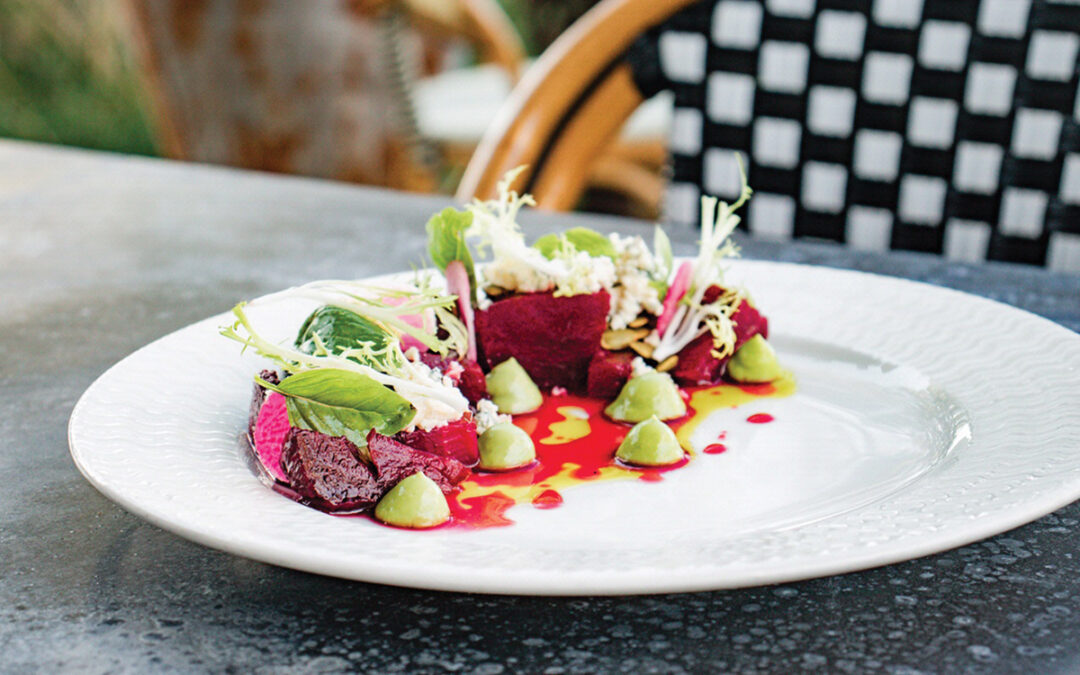Brush past a rosemary bush and inhale its bracing perfume. Or rub the spiky leaves of lemon verbena between your fingers and enjoy their citrus scent.
Fresh herbs have the capacity to open up a world of sensory pleasures, and their uses are infinite. Whether you love to garden, cook, or just sip a cup of tea, you’ll find that fresh herbs are some of nature’s most useful plants. Fresh herbal infusions make lovely caffeine free alternatives to regular teas and coffee. Breads, both sweet and savory, benefit from the addition of herbs. Try adding a teaspoon or so of chopped rosemary and some cheddar cheese to your muffins or biscuits. Herbed butters enhance the simplest dishes. Chop a tablespoon each of fresh dill and Italian parsley, add to 2 sticks of softened butter, a squeeze of lemon juice and salt and pepper; spread it on pita breads and toast them in the oven. Salsas and pestos are obvious vehicles for herbs, as are salad dressings.
Growing your own fresh herbs ensures you’ll always have that sprig of mint to enliven your glass of iced tea, that cupful of basil for pesto to top tonight’s pasta or grilled chicken or a handful of tart arugula for a sassy salad. But even if you can’t grow your own, our markets now indulge us with an opulent array of colorful, fragrant herbs. It wasn’t always that way. Unless we grew our own herbs, most of us grew up with bottles of dried herbs. They have their place, certainly, but generally they lack the flavor and aroma of the fresh. (Dried oregano and thyme are exceptions — they’re more pungent than their fresh forms and are preferred by many cooks in some recipes.) Dried herbs lose their potency after a few months, especially if they’re stored near a hot stove or exposed to direct sunlight, so purge your herb and spice shelf of old jars and replenish with bright new ones from a good source. If you’re intrigued with the idea of planting your own herb garden, check out these excellent books: Southern Herb Growing by Madalene Hill and Gwen Barclay and The Herb Garden Cookbook by Lucinda Hutson. And the indispensable Texas Organic Vegetable Gardening by J. Howard Garrett and C. Malcolm Beck will provide guidance on growing herbs, vegetables, fruits and more the natural way. Beck’s GardenVille is the ideal source for all your organic gardening needs.
You can start with just a few containers of herbs, or if you’re up to the challenge, prepare a special bed in your yard. If using containers, consider large clay pots or wooden barrels. They are usually recommended over plastic because they hold moisture and keep temperatures on an even keel. Fill the pots with a light organic soil. Heavy soils impede the growth of delicate herbs. For your beds, you’ll want to find a spot that has six or so hours of sun, preferably morning sun. A raised bed is ideal — it’s easier to tend and has the capacity for building a deep bed of good healthy soil that drains well. Which herbs should you plant? Do your homework to ascertain each herb’s favored growing conditions. Some, such as arugula, cilantro, dill, parsley, fennel and salad burnet, do better in cool weather and are perfect for the fall garden. Others, such as oregano, chives, sage, sweet marjoram, mint and rosemary, do well pretty much all year long, although in the event of a hard freeze that stays around for several days, you’ll want to protect them.
Most others, especially those used in Asian and Mexican cooking, thrive in the heat of summer. Plant herbs with similar water needs together. Mint and basil require more water than woody stemmed herbs such as rosemary and lavender.
The basics for cooking include basil, parsley, mint, rosemary, thyme, sage and chives. If you love to cook Mexican food, you’ll want to plant cilantro, hearty Mexican mint marigold and Mexican oregano. You could include epazote for cooking your beans or even sarsaparillaor licorice flavored hoja santa. It sports large, velvety leaves that are marvelous used as wrappers for grilled fish fillets or chicken breasts. For those who favor cooking Asian foods, the herb bai krapow, or Thai (a.k.a holy) basil is a must, along with mint and cilantro. Lemon grass is another essential in Asian cuisines. It resembles a clump of Johnson grass, but the lower bulbous portion is prized for its delicate lemony flavor and aroma. It flavors Thai chicken and shrimp soups and other dishes such as Thai curries, along with cilantro and kaffir lime leaves.
At Sarika’s Thai Cuisine, cilantro plays a starring role in their light and healthful Seafood Salad.
SARIKA’S SEAFOOD SALAD
Seafood:
1 cup sliced squid
1 cup peeled shrimp
1 cup green lipped mussels, scrubbed clean
Sauce:
3 tablespoons fresh lime juice
3 tablespoons fish sauce
1 tablespoon sugar
1 tablespoon Sriracha sauce
4 cups romaine lettuce, cut into strips
1/2 cup finely chopped white onion
1/2 cup sliced scallions
1/2 cup chopped cilantro leaves
Seafood: Bring water to a boil in a medium pot, add squid and simmer gently for just a minute. Remove with a slotted spoon and set aside in a bowl. Repeat with shrimp; add to the bowl, and then repeat with mussels. Don’t overcook the seafood.
Sauce: Combine lime juice, fish sauce, sugar and Sriracha sauce in a small bowl.
To serve: Place romaine on a serving platter. Pour the sauce over the seafood, add white onion, scallions and cilantro. Mix gently, and spoon onto the romaine. Makes 4 servings.
A wonderful source for all your herb needs is Nature’s Herb Farm, owned by veteran grower Mary Dunford. The farm is at 7193 Old Talley Road #7, outside 1604, just off highway 471 on the road to Castroville. Dunford is the originator of San Antonio’s yearly Herb Market. Her growing “green” extends even to capturing rainwater for use on the herbs. Her assistant, Carollee Fisher, says the plants grow faster and that there are no water spots on the leaves. If you’re able to follow their example and find a means to capture rainwater, your water bills will decrease and the plants will flourish.
Here is Dunford’s favorite Herbed Cream Cheese Spread, which uses a variety of fresh herbs. It includes her recipe for pesto. You can double the pesto recipe and then tuck the extra into small jars, top with a spoonful of olive oil, cover and refrigerate for several days, or freeze up to six months. The cheese features a variety of herbs and is garnished with blossoms of basil and chives.
NATURE’S HERB FARM’S HERBED CREAM CHEESE WITH PESTO
Cheese mixture:
3 tablespoons chopped fresh herbs of choice
(Mary suggests chives, lemon thyme, lemon balm and a touch of grated lemon rind, OR just Mexican mint marigold and grated lemon rind)
2 teaspoons minced fresh garlic 8 ounces cream cheese (or Neufchatel), at room temperature
Salt and freshly ground pepper, to taste
Pesto:
1/2 cup packed fresh sweet basil leaves, washed and dried
1 large clove garlic, peeled and chopped
1/4 cup nuts (pine nuts, walnuts or pecans)
1/4 cup olive oil
1/4 cup freshly grated Parmesan cheese
Salt and freshly ground pepper
Garnish:
Basil blossoms or chive blossoms
Cheese: Combine herbs, garlic, cheese, salt and pepper in the bowl of a food processor; pulse until mixture is smooth, but NOT until the herbs are puréed.
Pesto: Combine the basil, garlic and nuts in a blender or food processor. With motor running, slowly add the oil in a stream. Add Parmesan cheese and pulse just to combine, then season to taste with salt and pepper.
To assemble: Layer half the cheese mixture in a 5 to 6 inch paté dish or bowl. Spread a 1/4 inch layer of pesto over the cheese mixture. Top with the last half of the herbed cream cheese. Cover and refrigerate, but bring to room temperature before garnishing with basil blossoms. Serve with crackers, toasted bagels or pita crisps. Makes 4 to 6 appetizer servings.
Chef David Gates heads up the kitchens at Anne Marie’s Carriage House Bistro, situated in the Botanical Garden. WIth these beautiful gardens just outside his doorstep, he has a cornucopia of fresh herbs to choose from. Here is his Herbed Pasta Salad with Seared Yellowfin Tuna that features five different herbs.
ANNE MARIE’S CARRIAGE HOUSE BISTRO HERBED PASTA SALAD WITH SEARED YELLOWFIN TUNA
2 cups cooked farfalle pasta (al dente)
6 ounces yellowfin tuna
6 large shrimp 1/8 cup purple (red) onion, diced
1 bunch scallions, sliced
1/4 cup red bell pepper, diced
1 rib celery, diced
3 baby carrots, diced
Juice of 1 lemon
1/4 cup mayonnaise
1 teaspoon Thai chili sauce
Salt and pepper, to taste
Fresh Herbs:
2 sprigs dill
2 sprigs cilantro
2 sprigs flat leaf (Italian) parsley
3 basil leaves
3 to 4 leaves Mexican mint marigold (be careful — their flavor is strong)
Mixed greens
Cherry tomatoes, to garnish
Cook pasta. Sear the tuna on both sides, taking care to cook just to medium rare. Cool the tuna and place in refrigerator. Cook the shrimp, drain, and cut into pieces. In a large bowl, combine the pasta, shrimp, onion, scallions, red pepper, celery and carrots. Add the lemon juice, mayonnaise and chili sauce. Chop the fresh herbs and add to the bowl; combine and chill.
To serve, slice the tuna into strips. Place a bed of mixed greens on two plates, divide the pasta mixture between the plates and place tuna strips over the pasta. Garnish with tomatoes. Makes 2 servings.









0 Comments